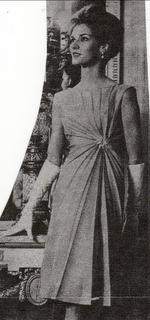
The sunburst dress was a piece in my spring collection for 1962. A proud moment was when the Boston Sunday Herald photographed it for a full page article in its Sunday Magazine, March 4, 1962. Under the photo was the following:
“SUNBURST is the name given to this new style by young Boston designer Shirley Willett. Of bright orange silk pesante, the dress is hand pleated and all the fit is within the pleating.”
It certainly goes along with today’s spring 2007 collections in which orange is a color choice of Paris fashions. A piece from the article:
“SHIRLEY WILLETT is one of Boston’s new young designers who shows an originality of design and individuality of concept that is unusual for her twenty-eight years. She is an exponent of cut and shape and believes that each garment must have something unique as well as flattering for the wearer. Shirley also feels that high fashion design warrants superior workmanship in order to be recognized as true couturier. Because of her fresh young approach we felt her styles will be of great interest to the new, young brides of 1962.”
The early 1960s was a time of extensive technical research for me, a time of intense creativity that would challenge every engineering skill I could dream up, in order to result in simplicity and the ability to reproduce easily, yet maintain the intense originality. It was a time of fashion shows, and a small but loyal group of customers, before I went into manufacturing and selling to retailers. However, because I was so devoted to research and self-learning, I made no money. But, it didn’t matter. I was a “fashion sculptress”, and supported my art in other ways. I look back at that period nostalgically. It was my kind of schooling because everything I know was self-taught. That self-teaching is what helped me to create the original technologies and educational principles that won me National Science Foundation grants in the late 1980s, after I sold my manufacturing business.
Saying the “fit is within the pleating” means that all the shaping for the bust, the waist, the hips, and in the back as well as the front – all comes into the sunburst point in the front. The way I approached the pattern then was to “slash the paper pattern” wherever I wanted the pleating to fall, and add in whatever amounts I determined. It was very complicated, a technical challenge. Today I would do it quite differently. In fact, as I tell my students and protégés, the best quality and easiest approach to complicated draping as here, is to start with my basic “dress primitive” and then drape on top of it. This is very simple explanation of something that needs a lot of visuals to help understand the principles.
Another feat I accomplished is the soft armhole. Women in the 1960s considered the armhole line hard and ugly, and did not like showing their underarms. Study the soft drape I achieved over the arm. It means the lining does the work of being a support , a different shape than the shell, in order to support the drape. Again, it would take some visuals to full grasp the technique.
I get so many questions on how to achieve some of these things that I am playing with ideas of how to do this online. What do you think? Let me know.

3 comments:
Wow! Great design.
That is a beautiful design, thanks for sharing it. I would love to read and learn more about your designs and hope you will find a way to do this online.
I THINK YOU ARE DOING GREAT FOR THE FASHION FRATERNITY! THANK U...!
Post a Comment